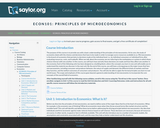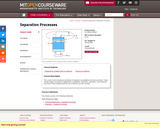31 Results

- Subject:
- Economics
- Material Type:
- Unit of Study
- Provider:
- Rice University
- Provider Set:
- OpenStax College

By the end of this section, you will be able to:
Explain protectionism and its three main forms
Analyze protectionism through concepts of demand and supply, noting its effects on equilibrium
Calculate the effects of trade barriers
- Subject:
- Applied Science
- Material Type:
- Module
- Date Added:
- 09/20/2018

- Subject:
- Economics
- Material Type:
- Unit of Study
- Provider:
- Rice University
- Provider Set:
- OpenStax College

By the end of this section, you will be able to:
Predict shifts in the demand and supply curves of the labor market
Explain the impact of new technology on the demand and supply curves of the labor market
Explain price floors in the labor market such as minimum wage or a living wage
- Subject:
- Applied Science
- Material Type:
- Module
- Date Added:
- 09/20/2018

The purpose of this course is to provide the student with a basic understanding of the principles of microeconomics. At its core, the study of economics deals with the choices and decisions that have to be made in order to manage scarce resources available to us. Microeconomics is the branch of economics that pertains to decisions made at the individual level, i.e. by individual consumers or individual firms, after evaluating resources, costs, and tradeoffs. "The economy" refers to the marketplace or system in which these choices interact with one another. In this course, the student will learn how and why these decisions are made and how they affect one another in the economy. Upon successful completion of this course, students will be able to: Think intuitively about economic problems; Identify how individual economic agents make rational choices given scarce resources and will know how to optimize the use of resources at hand; Understand some simplistic economic models related to Production, Trade, and the Circular Flow of Resources; Analyze and apply the mechanics of Demand and Supply for Individuals, Firms, and the Market; Apply the concept of Marginal Analysis in order to make optimal choices and identify whether the choices are 'efficient' or 'equitable'; Apply the concept of Elasticity as a measure of responsiveness to various variables; Identify the characteristic differences amongst various market structures, namely, Perfectly Competitive Markets, Non-Competitive Markets, and Imperfectly Competitive Markets and understand the differences in their operation; Analyze how the Demand and Supply technique works for the Resource Markets. (Economics 101; See also: Business Administration 200)
- Subject:
- Business and Communication
- Economics
- Management
- Social Science
- Material Type:
- Assessment
- Full Course
- Lecture
- Lecture Notes
- Reading
- Syllabus
- Textbook
- Provider:
- The Saylor Foundation
- Date Added:
- 09/07/2018

General principles of separation by equilibrium and rate processes. Staged cascades. Applications to distillation, absorption, adsorption, and membrane processes. Phase equilibria and role of diffusion. 10.32 will be offered for 6 units starting spring 2004.
- Subject:
- Biology
- Natural Science
- Material Type:
- Full Course
- Provider:
- M.I.T.
- Provider Set:
- M.I.T. OpenCourseWare
- Author:
- Dalzell, William
- Date Added:
- 01/01/2005

Statica is de leer van mechanisch evenwicht.
Een lichaam beweegt niet (of is in een éénparige rechtlijnige beweging) als de som van de krachten die op dat lichaam werken nul is. Als ook de som van de momenten die op dat lichaam werken nul is, dan roteert het lichaam ook niet.
De consequentie van deze twee evenwichtsvoorwaarden (som van krachten =0 en som van momenten =0), is dat voor een lichaam waarop een aantal bekende krachten werken de (onbekende) reactiekrachten bepaald kunnen worden .
Dit is van groot belang omdat de grootte van de reactiekrachten de dimensionering en materiaalkeuze van toe te passen componenten bepalen.
Binnen het vak “Statica” wordt in detail ingegaan op de verschillende mechanische belastingen, vaak voorkomende constructies en hoe te rekenen met de diverse belastingen.
- Subject:
- Applied Science
- Engineering
- Physical Science
- Physics
- Material Type:
- Assessment
- Lecture
- Reading
- Provider:
- Delft University of Technology
- Provider Set:
- Delft University OpenCourseWare
- Author:
- Prof.dr. G.C.A.M. Janssen
- Date Added:
- 04/25/2019

Statics deals with the principles of equilibrium. In this course the principles of forces and moments will be explained as well as principle of equilibrium of forces and moments. This also includes the equilibrium of 2D and 3D structures and trusses. Furthermore the principle of internal forces and moments is addressed as well as the use of the principle of virtual work to calculate both external and internal loads. Finally, the concepts of centre of gravity, centroids and moments of inertia are discussed
- Subject:
- Physical Science
- Physics
- Material Type:
- Lecture Notes
- Reading
- Provider:
- Delft University of Technology
- Provider Set:
- Delft University OpenCourseWare
- Author:
- A.S.J. Suiker
- G.N. Saunders
- J. Remmers
- Date Added:
- 02/21/2016

This subject deals primarily with equilibrium properties of macroscopic systems, basic thermodynamics, chemical equilibrium of reactions in gas and solution phase, and rates of chemical reactions.
- Subject:
- Chemistry
- Physical Science
- Material Type:
- Full Course
- Provider:
- M.I.T.
- Provider Set:
- M.I.T. OpenCourseWare
- Author:
- Bawendi, Moungi
- Nelson, Keith
- Date Added:
- 01/01/2008

